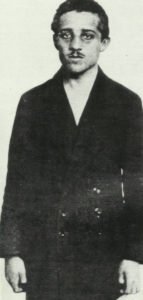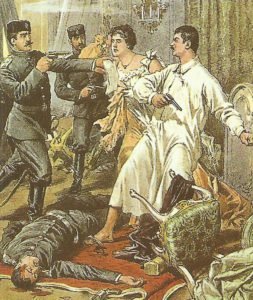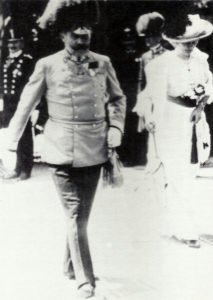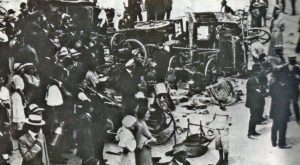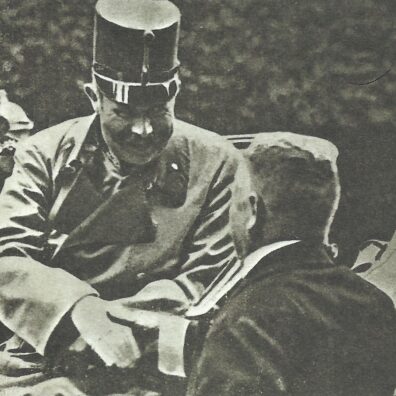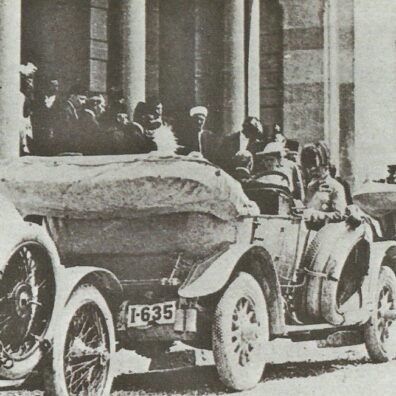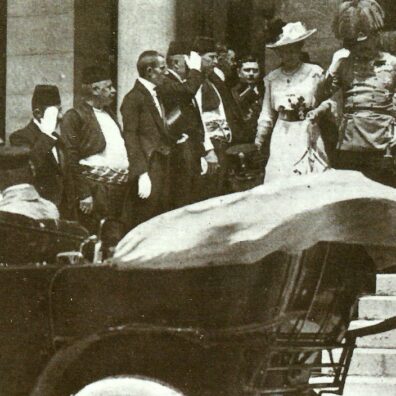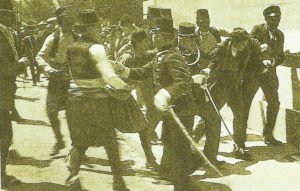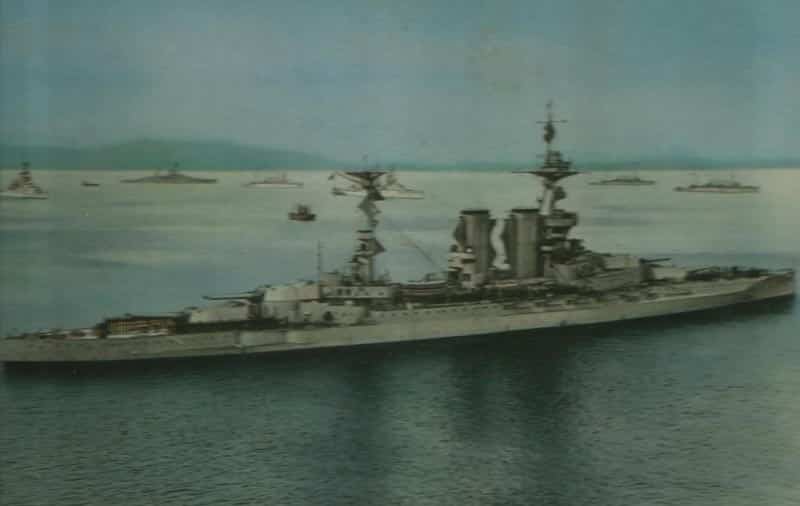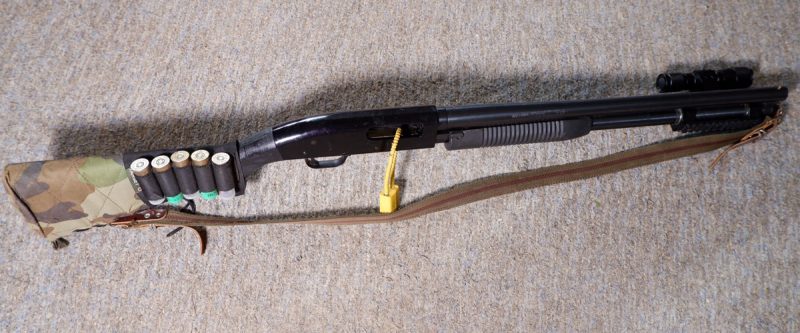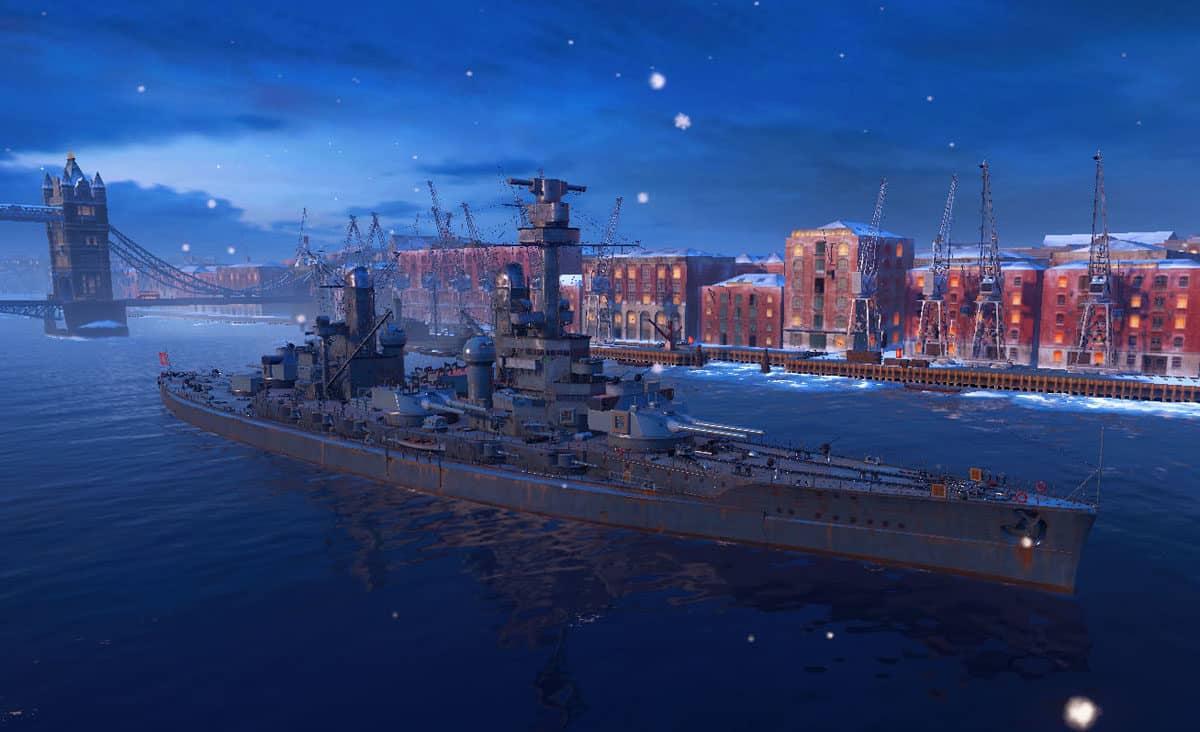The Sarajevo assassination of Archduke Franz Ferdinand on 28 June 1914.
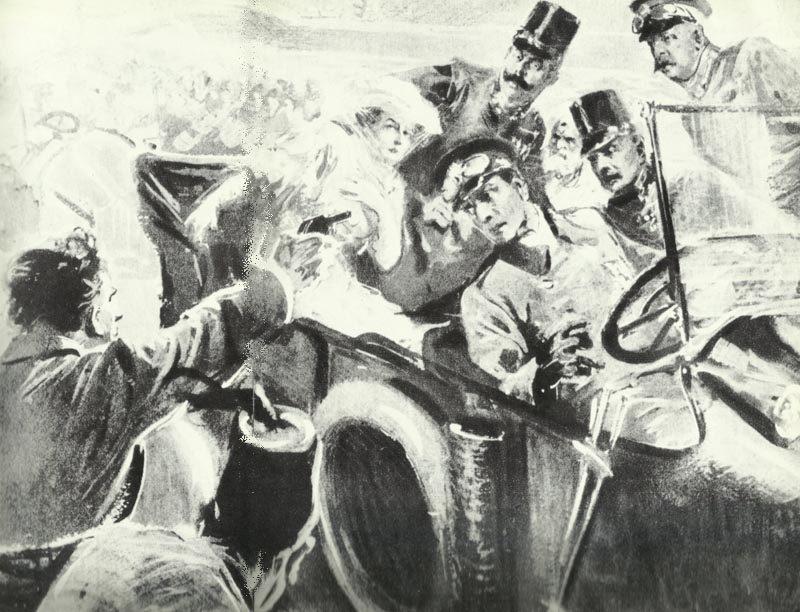
The murder of an important political figure often had important consequences, but the shooting of the heir of the Austro-Hungarian Dual Monarchy in 1914 led to the World War One.
Sarajevo assassination
Table of Contents
The Austro-Hungarian retaliation by the attack on Serbia and the network of international military alliances caused the world to slide into a terrible conflict. Four great empires were to perish and the world is still marked by the consequences.
Already in December 1913 a Serbian newspaper from Chicago in the USA wrote that the Austrian heir to the throne had announced his visit to Sarajevo for the coming spring of 1914. ‘Every Serb should prepare himself, because if the heir to the throne visits Bosnia, we will pay the costs – with knives, rifles, bombs and dynamite. Take holy revenge and death of the Habsburg dynasty’, was written there.
The only person who could prevent the future existence of Austria-Hungary and thus prevent a ‘Great Serbian Empire’ in the Balkans was the Archduke and heir to the throne Franz Ferdinand. He planned to reform Austria-Hungary after his accession to the throne, with the two southern Slavic provinces of Bosnia and Herzegovina forming an autonomous state. This might have soothed the Serbs living there and given them enough autonomy to let their nationalist aspirations fall asleep. Therefore, Franz Ferdinand was the greatest enemy of the Serbian ultra-nationalists.
On 24 June 1914, heir to the throne Franz Ferdinand and his wife Sophie left for Bosnia for the maneuvers planned there. While the Archduchess visited orphanages, schools and churches, Franz Ferdinand took part in the maneuvers as Inspector General of the Austro-Hungarian Army, with no incidents.
Still, on the evening of June 27, Sophie said that all fears had been in vain and that they had been received everywhere with great cordiality. The return journey was planned for the next day, with the mayor of Sarajevo inviting them to a banquet on the way.
The Black Hand
They had already supplied themselves with weapons. These included pistols and bombs they had received from the Serbian Major Tankosic, one of the leaders of the ‘Black Hand’. The ‘Black Hand’ was under the all-encompassing command of Colonel Dimitrijevoc-Apis and the weapons had been smuggled across the border from Belgrade.
The terrorist alliance ‘Black Hand’ was also supported by the Tsar’s government, which hoped that all groups of ‘Pan-Slavism’ would come under Russian auspices to control the Balkans and perhaps even gain the desired access to the Mediterranean and via Constantinople and the Dardanelles.
All the conspirators knew their duties and now they have taken up their posts. Five of them took up positions along the river Miljacka, which in early summer was now only a small stream at the bottom of a wide riverbed. Mehmedbasic, Cabrinovic and Cubrilovic stood at the junction of the Appel quay and the Cumuria bridge, while opposite Popovic, who was first with IIlic, looked over at them. At this point they thought their task would be most likely to succeed.
Further along the river bank, at its junction with the Latin Bridge, stood Princip and further along the river near the Town Hall, Grabez waited as ‘last hope’ if his friends had no luck before.
Arrival of the Archduke
They were all at their posts around 9 a.m. and had to wait almost an hour for their intended victim to arrive.
Archduke Franz Ferdinand, heir to the Habsburg Monarchy of Austria-Hungary, had already received so many general warnings about the possibility of an assassination during his lifetime that at the age of 51 he listened even to the most exact warnings with a tired fatalism.
‘I am sure that their warning is justified’, he sighed as he was told that he could find his end in Sarajevo, ‘but I will not stand under a glass dome. Our lives are in constant danger. One must be able to rely on God’. He therefore instructed that the program for his visit to the Bosnian capital should not be restricted.
Now the program would not be changed anymore just because there were more rumors about another assassination attempt in circulation, which would undoubtedly turn out to be unfounded again.
With this attitude he instructed the police in Sarajevo only with extremely poor security measures. The local police seems to have completely ignored the fact that the visit took place on the day of the biggest Serbian festival, St Vitus’ Day. Serbian patriots, who were always a passionate ethnic group, would almost certainly regard this as excessive annoyance and unnecessary harassment.
The Archduke’s train arrived punctually at the Sarajevo railway station at 10 a.m. and ten minutes later a column of four cars was on its way to the official reception in the City Hall. In the leading car there was the mayor and the police chief, in the second the archduke in full uniform with his beloved wife, Duchess Sophie von Hohenberg, next to him. The Governor of Bosnia, General Potiorek, sat opposite, while the owner of the car, Count Harrach, sat in the front seat next to the driver.
Then followed two cars with officers and accompanying persons of the ducal chamber.
First assassination attempt
The cars drove fast over the Appel quay, between the houses on the left and the small dam wall on their right. As they approached the Cumuria Bridge, General Potiorek turned around and showed his uninterested guests the new barracks they were approaching.
At the same moment, a tall young man in a long black coat and a black hat asked a policeman in which car the Archduke was sitting. The moment he received an answer, he broke the cap of a grenade and threw it at his target with admirable accuracy but bad luck. He then jumped over the bank wall and fled along the riverbed.
With a courage and compassion worthy of admiration, the Archduke ordered the driver to stop the car in order to inform himself about the damages and losses. Then the column, reduced to three cars, continued its journey to the reception at the town hall.
The route was shortened because of the incident and its effects on the Archduke’s composure, which was not improved by the finding that a piece of the grenade had grazed his wife’s neck.
‘I come here for a visit and I get bombs thrown at me, it’s outrageous’ the Archduke complained angrily later to Count Harrach, ‘I think we’ll get some more bullets’.
Arriving in the town hall, however, he calmed down again after it was reported that the assassin had been arrested. The mayor’s subsequent speech, however, was embarrassing because he had memorized it and didn’t adapt it to the assassination attempt. Now Franz Ferdinand wanted his wife to leave him safe, but she refused and wanted to stay with him.
General Oskar Potiorek was convinced, however, that there were no more murderers in Sarajevo who were after the heir to the throne. But to avoid further danger, the general suggested changing the program of the day slightly.
Instead of visiting the city museum as planned, which would mean that they would only have to drive over the Appel quay to the Latin Bridge, then turn right at the Schiller department store and continue along Franz-Josef street, it would be better to continue without it.
Instead, the column should go directly to the governor’s seat at Konak or back to Illidze. Both alternatives did not require more than driving back the entire Appel quay at full speed. The Archduke agreed and insisted only on a small detour at one point along the route. They wanted to visit the hospital where Colonel Merizzi was treated for his wounds so that both the Archduke and Duchess could express their sympathy and condolences.
So it was decided, but nobody thought about informing the drivers about the changed plan.
[amazon_link asins=’1908323752,B011MF026I,B01ET3105W’ template=’ProductGrid’ store=’wwto-20′ marketplace=’US’ link_id=’dcd013cf-7e55-4b5c-b771-70df34f2492a’]
The shots of Gavrilo Princip
From his post at the end of the Latin Bridge, Princip had heard the explosion of Cabrinovic’s bomb and soon realized that their target had escaped unharmed. He also saw Cabrinovic trying to escape along the riverbed and being pursued by the police, who soon caught him.
Princip first thought of pursuing them and shooting Cabrinovic with his pistol to preserve their secret and co-conspirators and then judge himself.
Princip, however, soon rejected these feelings, submerged between the crowd and finally took up post on the other side of the Appel Quay, on the corner of the Schiller department store. At this point the crowd, and he assumed the column would eventually slow down to turn into Franz-Josef street.
After all, it was even better from Princip’s point of view. The three cars approached the intersection as planned and the drivers, who were still not informed of the route changes, turned around the corner. But when the first car turned, Potiorek recognized the mistake and screamed to correct it. The first car picked up speed, but the Archduke’s one slowed down in the corner and stopped. The driver began to reset and turn to continue the route via Appel Quay. Very slowly the car passed Princip with its occupants at a distance of only about 1.65 yards (1.5 meters).
Princip then pulled the trigger twice. The first bullet penetrated the side of the car, the archduchess’s corset, and penetrated directly into her right side. The second bullet went through the Archduke’s coat collar, severed his neck vein and penetrated the spine. Both were already dead when they arrived at the hospital.
It was 11.30 a.m. on the morning of 28 June 1914, and we are still feeling the effects of these two shots.
The news of the Sarajevo assassination was about to spread around the world via telegraph lines and shocked most Europeans. Most of them were aware that, taking into account the alliance situation, this meant war. Only in Serbia was the murder glorified in the newspapers, while on the streets of Vienna outrage and hatred for the Serbs reigned and revenge was demanded.
References and literature
Illustrierte Geschichte des Ersten Weltkriegs (Christian Zentner)
History of World War I (AJP Taylos, S.L. Mayer)
Der Erste Weltkrieg – Storia illustrata della Prima Guerra Mondiale (Hans Kaiser)
The Illustrated Encyclopedia of Weapons of World War I (Chris Bishop)


